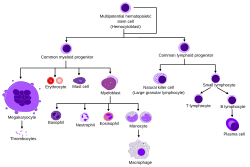Multipotent hematopoietic stem cell
| Hematopoietic stem cell | |
|---|---|

Overview of normal human hematopoiesis
|
|
| Details | |
| Identifiers | |
| Latin | Cellula haematopoietica praecursoria |
| Acronym(s) | HSC |
| TH | H2.00.01.0.00006 |
|
Anatomical terms of microanatomy []
|
|
Hematopoietic stem cells (HSCs) are the stem cells that give rise to other blood cells. This process is called haematopoiesis. This process occurs in the red bone marrow, in the core of most bones. In embryonic development, the red bone marrow is derived from the layer of the embryo called the mesoderm.
Hematopoiesis is the process by which all mature blood cells are produced. It must balance enormous production needs (more than 500 billion blood cells are produced every day) with the need to precisely regulate the number of each blood cell type in the circulation. In vertebrates, the vast majority of hematopoiesis occurs in the bone marrow and is derived from a limited number of hematopoietic stem cells (HSCs) that are multipotent and capable of extensive self-renewal.
HSCs give rise to both the myeloid and lymphoid lineages of blood cells. Myeloid and lymphoid lineages both are involved in dendritic cell formation (Myeloid cells include monocytes, macrophages, neutrophils, basophils, eosinophils, erythrocytes, and megakaryocytes to platelets. Lymphoid cells include T cells, B cells, and (natural killer cells). The definition of hematopoietic stem cells has evolved since HSCs were first discovered in 1961. The hematopoietic tissue contains cells with long-term and short-term regeneration capacities and committed multipotent, oligopotent, and unipotent progenitors. HSCs constitute 1:10.000 of cells in myeloid tissue.
...
Wikipedia
